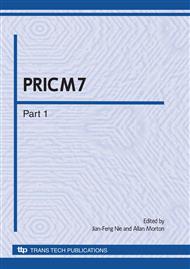p.2716
p.2720
p.2724
p.2728
p.2732
p.2735
p.2739
p.2743
p.2747
A Research on Interfacial Reaction of Brazing Joint of Alumina Ceramics to Metals
Abstract:
Brazing with active filler alloys containing some active elements, which promotes wetting of ceramics surfaces, is one of the most widely methods for joining ceramics to metals. The joints formed by brazing A12O3 to metal by using copper-titanium-nickel (Cu-Ti-Ni) as brazing filler were investigated. The metals/ceramics joints were produced at a vacuum level of 10-2-10-3 Pa at 1273K, using a constant holding time of 10 min. The surfaces were studied both morphologically and structurally using scanning electron microscopy (SEM), energy dispersive spectroscopy (EDS) and X-ray diffraction analysis (XRD). In the brazing process, copper and titanium in the braze alloy form a series of reaction products. The formation of Ti3Cu3O and Ti2Ni at the interface is characteristic of these joints. The estimated free energies of formation of the Ti3Cu3O and Ti2Ni are -119kcal/mol and -245.92 kJ ~-263.78kJ/mol at 1200~1288K respectively. The highly negative values for the free energies of formation suggest that these compounds are thermodynamically stable.
Info:
Periodical:
Pages:
2732-2734
Citation:
Online since:
June 2010
Authors:
Keywords:
Price:
Сopyright:
© 2010 Trans Tech Publications Ltd. All Rights Reserved
Share:
Citation:


